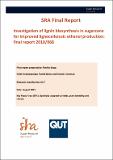| Author | Bewg, P |
| Date Accessioned | 2018-04-18 |
| Date Available | 2018-04-18 |
| Issued | 2015 |
| Identifier | http://hdl.handle.net/11079/17114 |
| Abstract | Second generation bioethanol is a renewable energy resource produced from lignocellulosic biomass with the potential to reduce reliance on oil-based energy. Sugarcane bagasse is an abundant source of lignocellulosic material available for bioethanol production. The utilisation of bagasse for biofuel production would be environmentally and economically beneficial, however, the lignin polymers restrict polysaccharide degradation by hydrolytic enzymes. Pretreatment is currently required to overcome the recalcitrant nature of lignin polymers, the cost of which prevents the cost-competitive production of bioethanol from lignocellulosic biomass. There is a strong consensus in published literature that reducing lignin content can increase glucose liberation during enzymatic hydrolysis from both wild type and genetically modified plants, including genetically modified sugarcane. Whilst lignin biosynthesis has received increasing research attention in some plant species, lignin biosynthesis and its manipulation in sugarcane has been explored only in recent publications and remains far from being fully understood. This thesis focuses on contributing to the limited knowledge available concerning lignin biosynthesis and secondary cell wall deposition in wild type sugarcane and the saccharification potential of genetically modified, lignin-reduced sugarcane bagasse through the completion of three specific aims. |
| Language | en |
| Publisher | Sugar Research Australia Limited |
| Part of Series | 2010/068 |
| Subject | Varieties |
| Subject | Plant breeding |
| Title | Investigation of lignin biosynthesis in sugarcane for improved lignocellulosic ethanol production: final report 2010/068 |
| Keywords | Sugarcane, lignin biosynthesis, transgenic |

